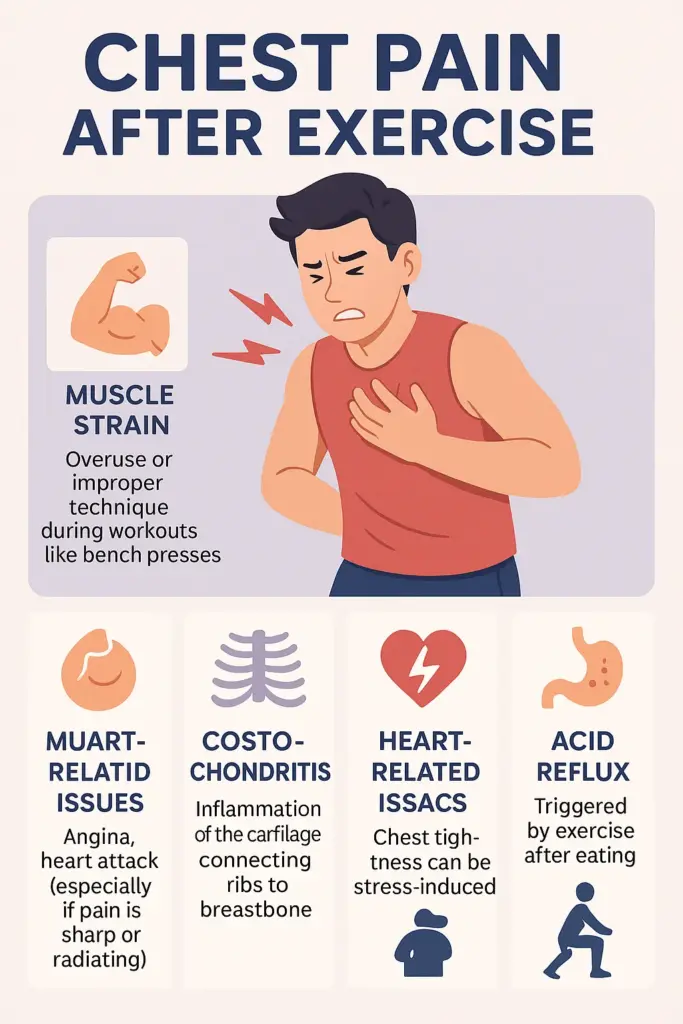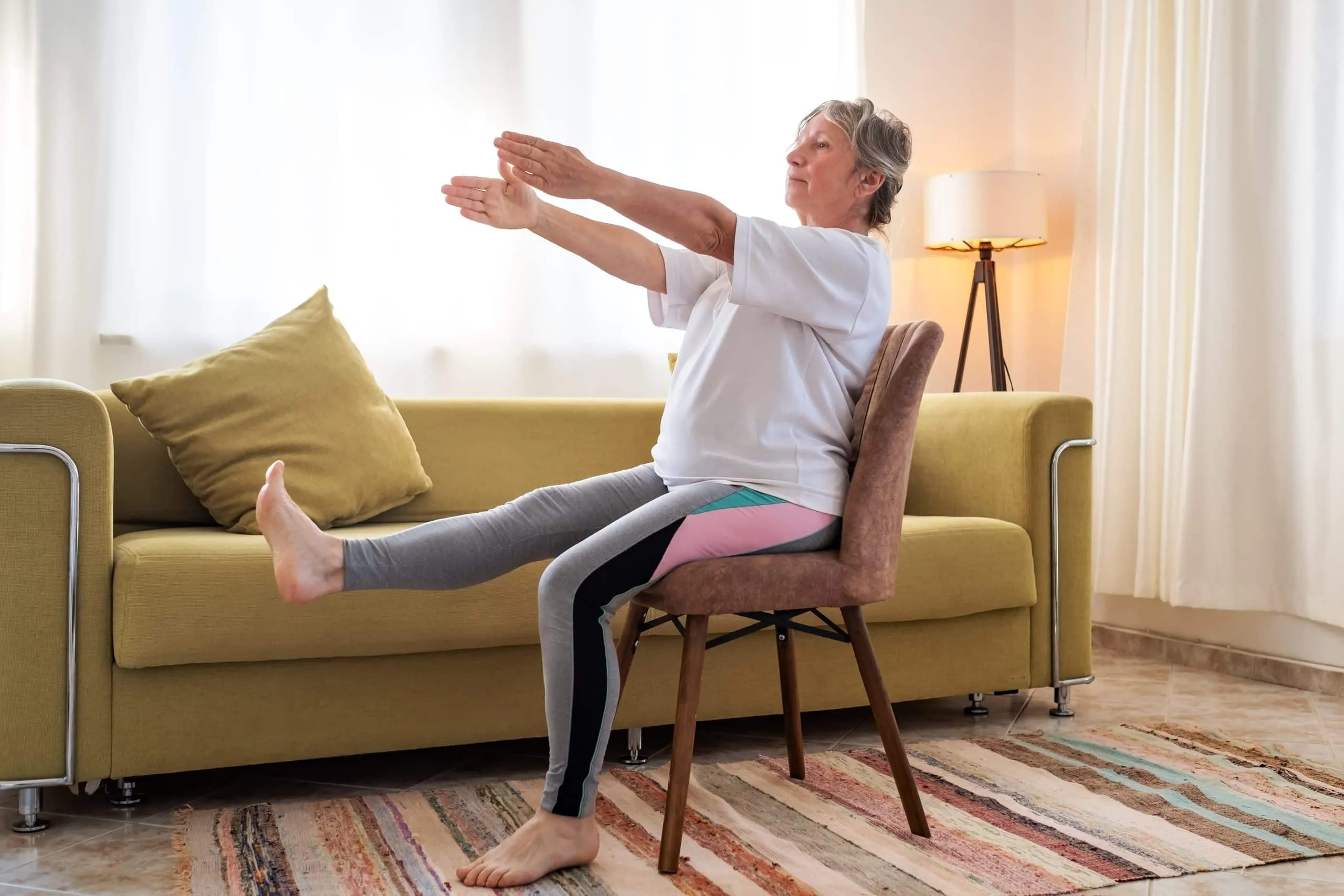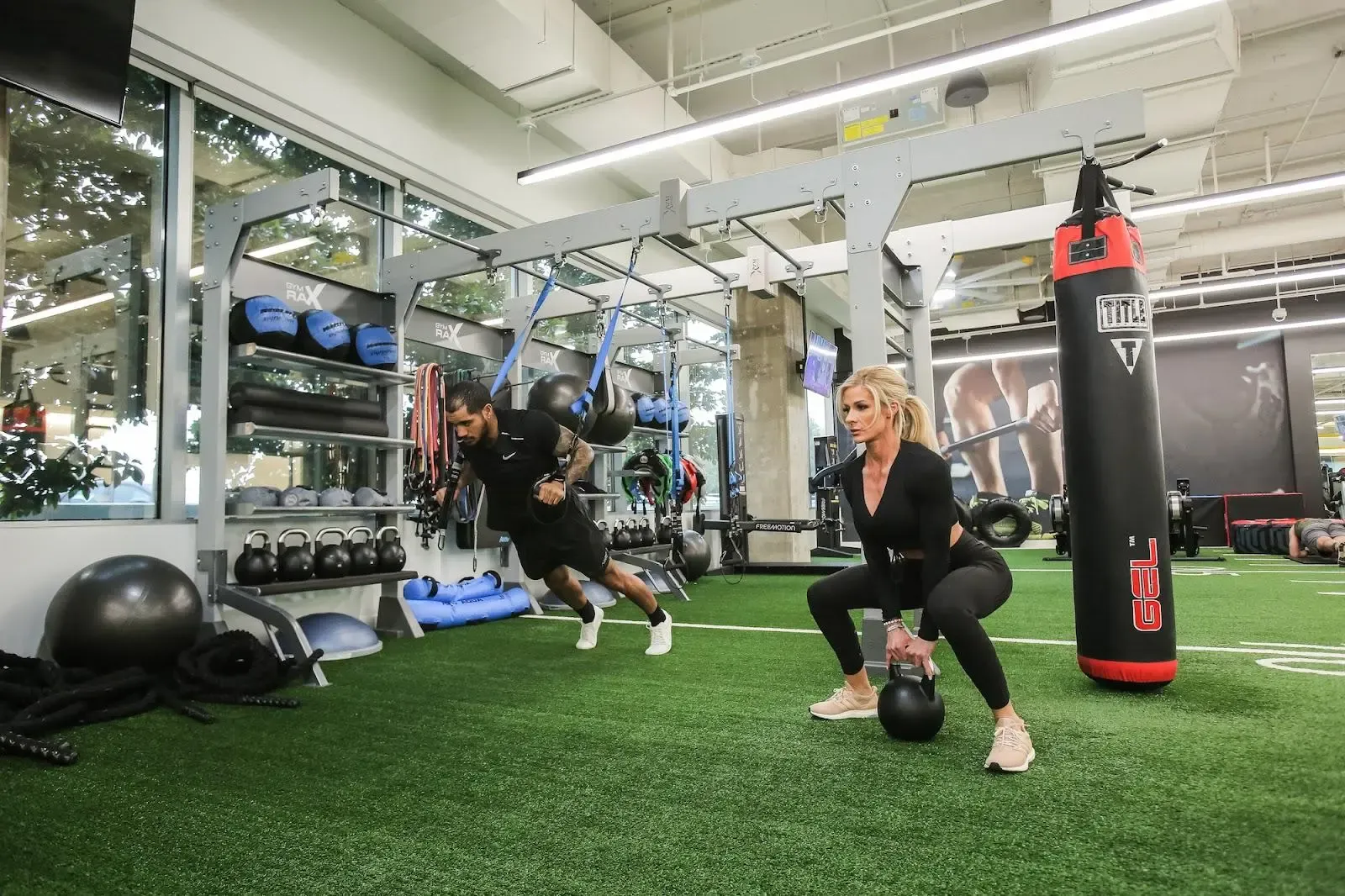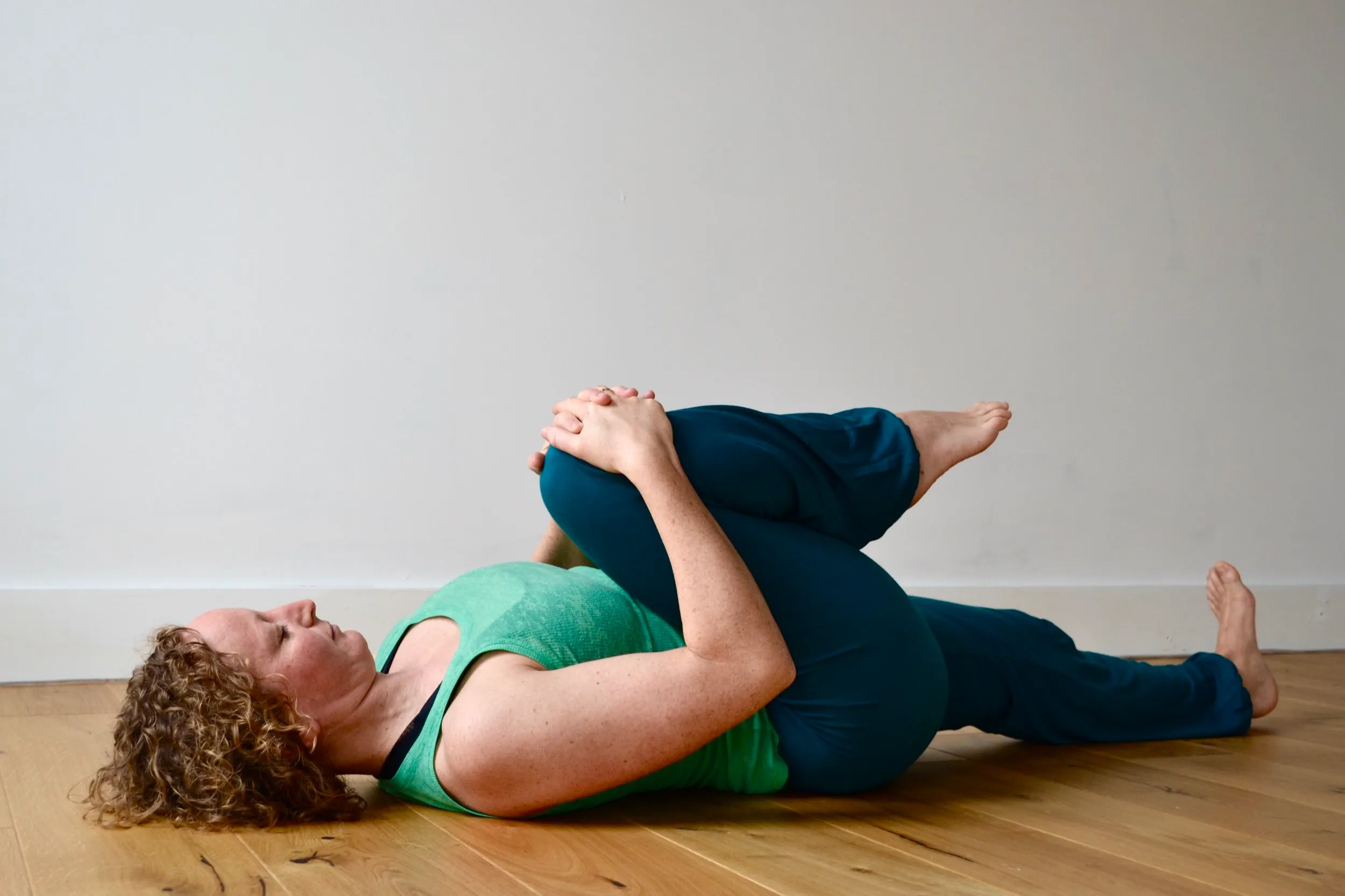Chest pain while exercising, or after it, can be scary. Whether you’re an athlete or exercise for general health, experiencing discomfort or pain in your chest can trigger immediate alarm bells, not least because chest pain is closely associated with heart problems.
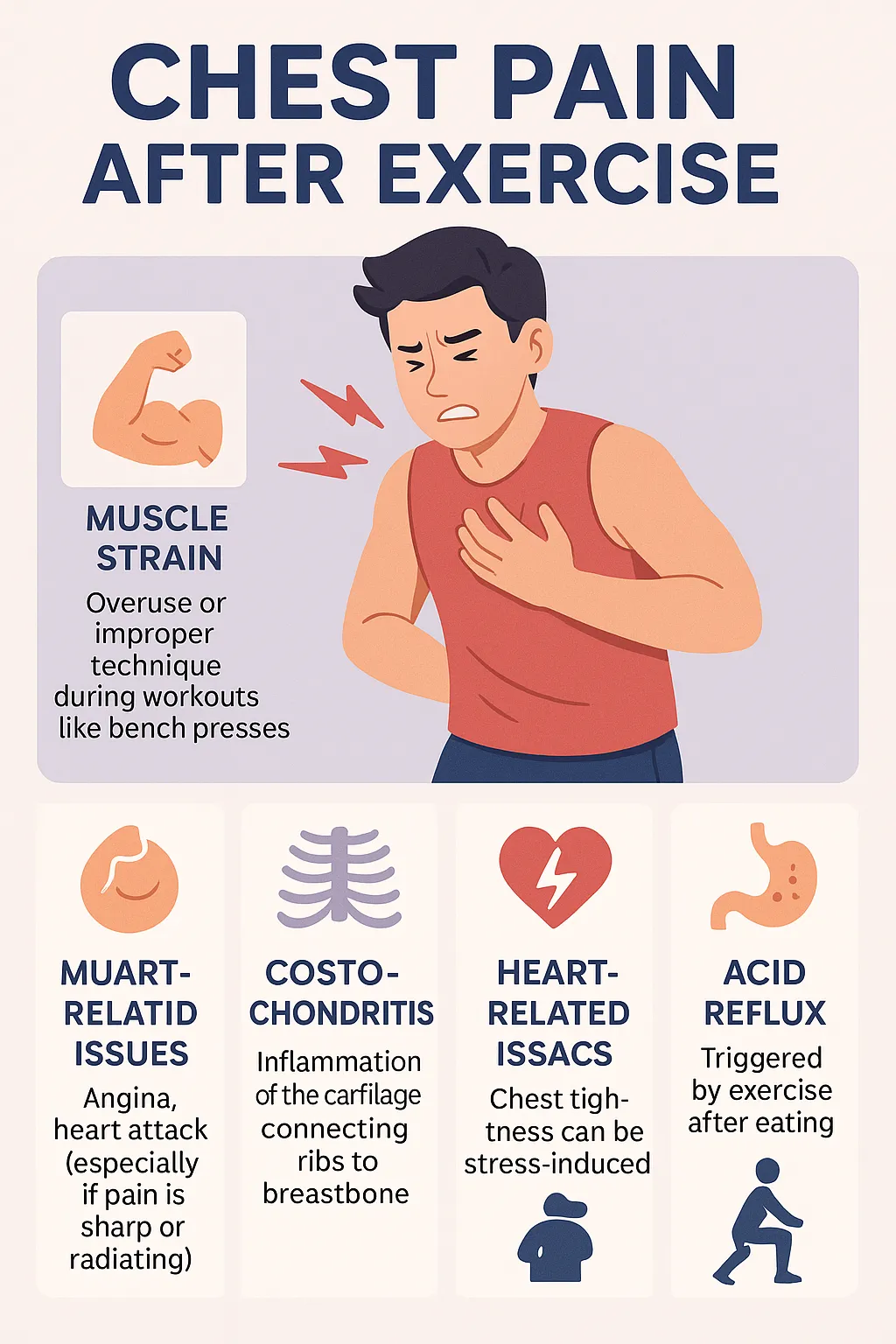
But not all chest pain is heart-related; in fact, some causes are benign or musculoskeletal. Understanding the potential reasons behind this pain is important for managing it properly and seeking professional medical help when necessary.
This blog discusses potential causes, diagnostic tests, treatments, and prevention strategies for exercise chest pain, so you are better informed in case you or someone you know experiences this alarming symptom.
Understanding Chest Pain
Chest pain is a symptom, not a diagnosis. It can originate from multiple structures in the chest, including the heart, lungs, oesophagus, muscles, ribs and nerves. Each condition that causes it is vastly different in the quality, length, and cause behind the pain itself.
Some describe the pain as sharp or stabbing, others as a dull ache, burning, tightness or pressure. It can happen during exercise or a few minutes afterwards, and it can be localised or radiate to areas including the neck, shoulders, arms or back.
Potential Reasons for Chest Pain Post-Exercise
1. Musculoskeletal Causes
Muscle strain — One of the most common culprits of post-workout pain in your chest. This happens when muscles or ligaments in the chest wall (especially the pectoral muscles or intercostal muscles between the ribs) are overworked or injured in strenuous or new workouts.
Characteristics:
• Localised pain
• Tender to touch
• Gets worse with movement or deep breaths
• No associated SOB or dizziness
For example, if you do a lot of heavy bench press or push-ups, you might experience some soreness and tightness in your chest for several hours or days.
2. Costochondritis
Costochondritis is inflammation of the cartilage that connects a rib to the sternum (breastbone). It can be caused by repetitive stress, overuse or trauma to the chest.
Symptoms:
• Extremely annoying pain on One Side of the chest
• Pain increases upon taking a deep breath or coughing
• Feeling tenderness when touching the chest area
3. Gastroesophageal Reflux Disease (GERD)
GERD or acid reflux can irritate your chest after exercise, especially if you’ve eaten shortly before a workout. When stomach acid flows back into the oesophagus, it can feel like the pain of a heart attack.
Symptoms:
• Burning sensation (heartburn)
• Sour taste in the mouth
• Pain worsens when lying down
• Relieved by antacids
4. Exercise-Induced Bronchoconstriction (EIB)
Also called exercise-induced asthma, EIB is marked by the narrowing of the air passages during or after physical activity.
Symptoms:
• Chest tightness
• Shortness of breath
• Wheezing
• Coughing
This is more common in people with asthma and can happen in other people, particularly in very cold or dry weather.
1. Cardiac Causes
Chest pain after exercise can be a sign of heart problems, though it’s less common in young and healthy people. These include:
2. Angina
Angina is chest pain that results from reduced blood flow to the heart muscle. It’s usually due to coronary artery disease (CAD).
Symptoms:
• Chest pain, pressure or tightness
• Pain that spreads to the arm, neck or jaw
• Occurs with exertion, relieved with rest
5. Myocardial Infarction (Heart attack)
Although uncommon in young athletes, a heart attack is possible, particularly in individuals with undetected heart problems or a family history of heart disease.
Symptoms:
• Crushing chest pain
• Sweating, shortness of breath, nausea
• Pain may not improve with rest
6. Hypertrophic Cardiomyopathy (HCM)
HCM is a hereditary condition that results in thickened heart muscles, which can block blood flow and cause chest pain when exerting oneself. It’s a top cause of sudden cardiac death in young athletes.
Warning signs:
• Chest pain with exertion
• Fainting or dizziness
• Irregular heartbeat
• Pulmonary Causes
7. Pulmonary Embolism (PE)
PE is a blockage in a lung artery by a blood clot. While not frequently an issue for healthy people after they work out, it can happen in cases of dehydration, long periods of inactivity or underlying disorders of clotting.
Symptoms:
• Sudden chest pain
• Shortness of breath
• Coughing up blood
• Rapid heart rate
8. Pneumothorax (Collapsed Lung)
Sudden sharp pain following exercise, especially if there’s been trauma or there’s underlying lung disease, could indicate a pneumothorax.
Diagnosis: Getting to the Heart of the Pain
If you have chest pain after exercise, particularly if it happens frequently or is severe, it’s important to see a doctor. Your health care provider will take a thorough history and do a physical exam, and then follow this with some tests:
• Electrocardiogram (ECG): Identifies irregularities in heart rhythms or signs of a heart attack.
• Chest X-ray: Drops a pen to make sure your lungs are doing just fine, with no broken bones or structural issues.
• Blood tests: Can show markers of heart damage (such as troponin) or inflammation.
• Echocardiogram: An ultrasound of your heart to examine its function and structure
• An exercise stress test: Evaluates your heart’s function when you exert yourself.
• CT scan or MRI: If there are structural problems or pulmonary embolism is suspected.
When to Seek Emergency Medical Care
Seek immediate medical attention if your exercise-related chest pain is also accompanied by any of the following:
• Shortness of breath
• Dizziness or fainting
• Sweating
• Nausea or vomiting
• Refers pain to the jaw, arms or back
• Irregular or rapid heartbeats
• Chest pain that does not resolve with rest
Resistance, don’t try to “push through” the pain or ignore it. When it comes to your heart and lungs, it’s better to err on the side of being overly cautious.
Treatment Options
Treatment for exercise-induced chest pain varies with the underlying cause:
1. Musculoskeletal Pain
• Rest and avoid further strain
• Use ice and over-the-counter anti-inflammatory medicine (e.g ibuprofen)
• Stretching and physiotherapy
2. GERD
• Avoid eating before exercise
• Take antacids or acid reducers such as proton pump inhibitors
• Change diet and steer clear of triggering items (spicy, fatty or acidic things)
3. Exercise-Induced Asthma
• Bronchodilators, inhaled, before exercise
• Warm-up and cool-down procedures
• Work out in cool, dry settings
4. Cardiac Conditions
Angina: Nitrates, beta-blockers, lifestyle modifications; possible angioplasty or bypass
Heart attack: Emergency treatment with meds or surgery
HCM: Heart-Rhythm Medications, Potential Surgery, Lifestyle Limits
5. Pulmonary Conditions
PE and pneumothorax, which require hospitalisation and intensive care
Prevention Strategies
Tips To Reduce the Risk of Chest Pain After Exercise:
1. Warm-Up and Cool-Down
Never skip these steps. Smoothly increase and decrease your intensity to let your body adapt.
2. Stay Hydrated
It also raises the odds of muscle cramps, blood clots and cardiovascular strain.
Know Your Limits
To avoid injury, be mindful not to overdo it, particularly when beginning a new workout regimen. Increase intensity gradually.
Eat Wisely
Don’t eat big meals before working out. If you’ve eaten, wait at least 1–2 hours before vigorous activity.
Monitor Heart Health
Regular check-ups, especially if you have risk factors such as high blood pressure, high cholesterol or a family history of heart disease, are critically important.
Important Considerations for Athletes and Exercise Lovers
If you’re an elite athlete or a frequent trainer, be aware that some heart conditions can be dormant until stress-testing them via intense exertion. If you experience any warning signs like these, consider getting a sports physical that includes ECG screening:
• Unexplained fatigue
• Syncope, or fainting spells, during or following exercise
• Palpitations or pounding heart
• Pre-participation cardiovascular screening is recommended for athletes by groups such as the American Heart Association.
Psychological Factors of Chest Pain
And recognise that anxiety and panic attacks can also mimic chest pain. During a panic episode, many people feel tightness in their chest, a racing heart, and shortness of breath. If other physical causes are excluded, consider talking with a mental health professional.
Final Thoughts
Chest pain following exercise is not to be trifled with. While it is often caused by benign conditions such as muscle inflammation or acid reflux, it can also be a warning sign of more serious health problems, including heart and lung conditions.
The nature of the pain, accompanying symptoms, and personal risk factors can all be useful in diagnosing and creating a treatment plan.
It’s best to seek a healthcare professional when in doubt. Better to err on the side of caution than to dismiss a possible medical crisis. By educating yourself, listening to your body, and taking precautionary measures, you can still enjoy the benefits of physical activity without risking your health.

